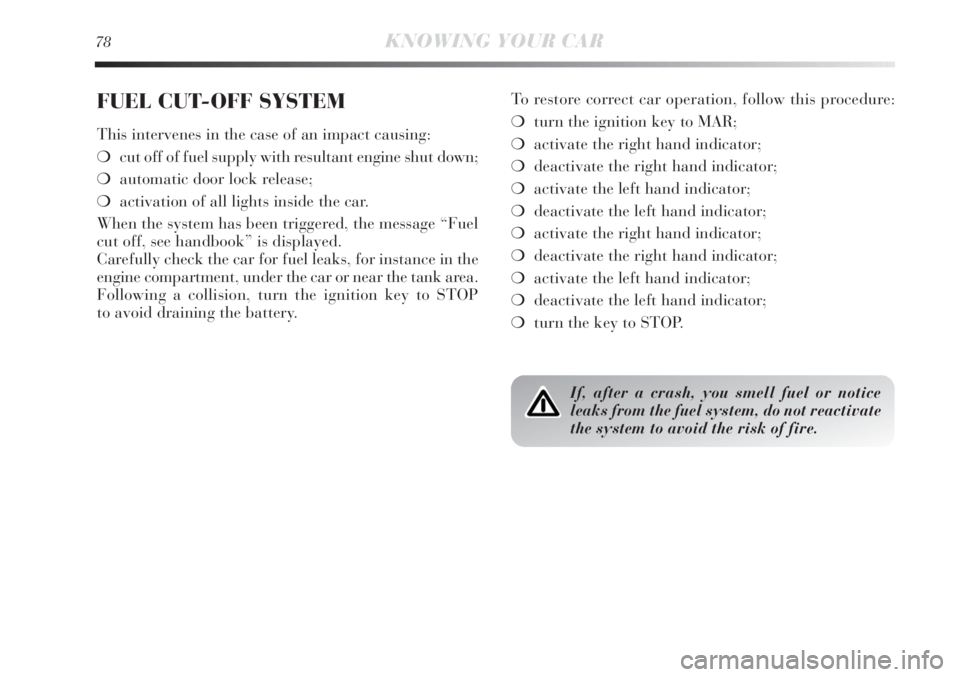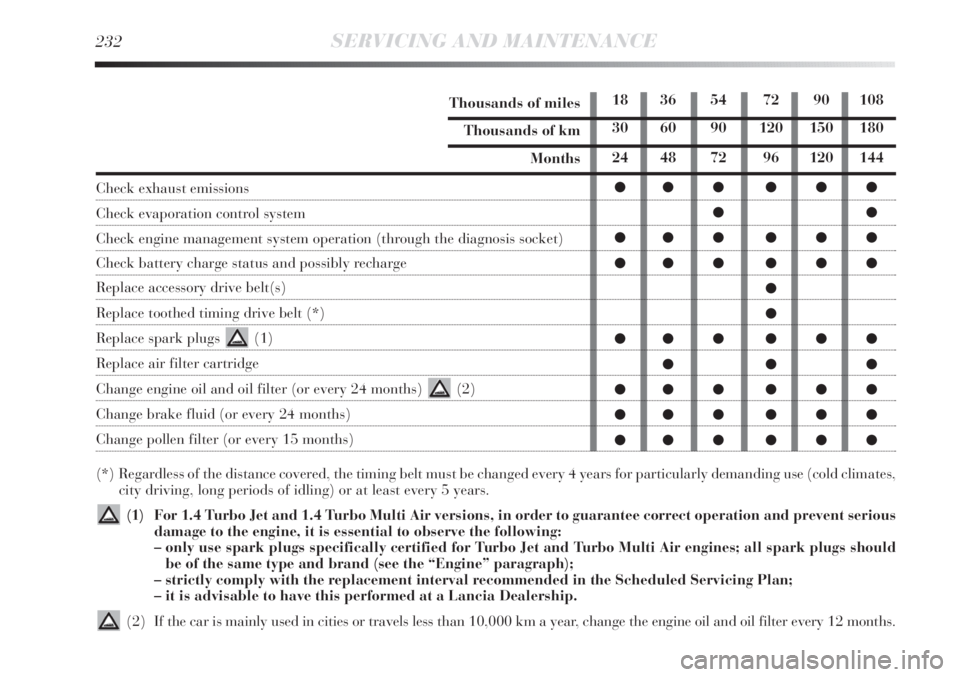Page 80 of 295

78KNOWING YOUR CAR
FUEL CUT-OFF SYSTEM
This intervenes in the case of an impact causing:
❍cut off of fuel supply with resultant engine shut down;
❍automatic door lock release;
❍activation of all lights inside the car.
When the system has been triggered, the message “Fuel
cut off, see handbook” is displayed.
Carefully check the car for fuel leaks, for instance in the
engine compartment, under the car or near the tank area.
Following a collision, turn the ignition key to STOP
to avoid draining the battery.To restore correct car operation, follow this procedure:
❍turn the ignition key to MAR;
❍activate the right hand indicator;
❍deactivate the right hand indicator;
❍activate the left hand indicator;
❍deactivate the left hand indicator;
❍activate the right hand indicator;
❍deactivate the right hand indicator;
❍activate the left hand indicator;
❍deactivate the left hand indicator;
❍turn the key to STOP.
If, after a crash, you smell fuel or notice
leaks from the fuel system, do not reactivate
the system to avoid the risk of fire.
Page 128 of 295

126KNOWING YOUR CAR
EOBD SYSTEM
The EOBD system (European On Board Diagnosis) car-
ries out a continuous diagnosis of the components of the
car related to emissions. It also alerts the driver, by turn-
ing on the
Uwarning light in the instrument panel to-
gether with a message in the reconfigurable multifunc-
tion display, when these components are no longer in
peak condition (see “Instrument panel warning lights”
paragraph).
The goal of the system is to:
❍to keep system efficiency under control;
❍to signal a fault which causes emission levels to
increase;
❍to signal the need to replace deteriorated components.
The system also has a diagnosis connector that can be in-
terfaced to suitable instruments, to read the error codes
stored in the control unit together with a series of specific
parameters for engine operation and diagnosis.
This check can also be carried out by traffic control au-
thorities.
Go to a Lancia Dealership as soon as pos-
sible if warning light
Ueither does not light
up when the key is turned to MAR or if,
while travelling, the warning light comes on either
steadily or flashing (along with a message in the
reconfigurable multifunction display). The oper-
ation of the warning light
Umay be checked by the
traffic control authorities using specific devices.
Always comply with the traffic regulations in force
in the country where you are driving.
IMPORTANT After eliminating the problem, to check the
system completely, Lancia Dealerships run a bench test
and, if necessary, road tests which may also call for a long
journey.
Page 189 of 295

3
STARTING AND DRIVING187
Keep your speed down when snow chains are
fitted. Do not exceed 50 km/h. Avoid pot-
holes, steps and pavements and also avoid
driving long distances on roads not covered with
snow in order to prevent damaging the car and the
roadbed.
SNOW CHAINS
The use of snow chains should be in compliance with lo-
cal regulations.
The snow chains may be applied only onto the front
wheel tyres (drive wheels).
Check the tension of the snow chains after the first few
metres have been driven.
IMPORTANT Snow chains cannot be fitted to the space-
saver spare wheel. So, if a front (drive) wheel is punc-
tured and chains are needed, a rear wheel should be fit-
ted to the front of the car and the space-saving spare
wheel should be fitted to the rear. This way with two nor-
mal drive wheels, snow chains can be fitted to them to
solve an emergency.
CAR INACTIVITY
If the car is to be left inactive for longer than a month,
the following precautions should be followed:
❍park the car in a covered, dry and, if possible, well-
ventilated place;
❍engage a gear;
❍check that the handbrake is not engaged;
❍disconnect the negative battery terminal (for versions
with Start&Stop system refer to the paragraph
“Start&Stop system” in chapter “1”);
❍clean and protect the painted parts of the vehicle with
protective wax;
❍clean and protect the shiny metal parts using special
compounds commercially available;
❍sprinkle talcum powder on the rubber windscreen and
rear window wiper blades and lift them off the glass;
❍open the windows slightly;
❍cover the car with a fabric or perforated plastic sheet.
Do not use sheets of non-perforated plastic as they
do not allow moisture on the car body to evaporate;
❍inflate tyres to a pressure of +0.5 bar above the nor-
mal specified pressure and check regularly;
❍do not drain the engine cooling system.
Page 197 of 295
IN AN EMERGENCY195
4
❍make sure that switch C-fig. 5 of the compressor is
in position 0 (off), start the engine, insert plug E-fig.
5a into the power socket and switch on the compres-
sor by placing switch D-fig. 5 in position 1 (on);
❍Inflate the tyre to the pressure specified in the “Cold
tyre pressures” paragraph, in chapter “6”. For a more
accurate reading, check pressure gauge D-fig. 5 with
the compressor off; ❍if after five minutes it is still impossible to reach at least
1.5 bar, disengage the compressor from the valve and
power socket, then move the car forwards for approx.
ten metres in order to distribute the sealing fluid inside
the tyre evenly, then repeat the inflation operation;
fig. 5L0E0078mfig. 5aL0E0288m
Page 198 of 295

196IN AN EMERGENCY
❍if after this operation it is still not possible to reach
at least 1.8 bar after five minutes, do not start driving
since the tyre is excessively damaged and the fast tyre
repair kit cannot guarantee suitable sealing. Contact
a Lancia Dealership;
❍if the tyre reaches the pressure specified in “Cold tyre
pressures” pressure in chapter “6”, start driving im-
mediately;
Apply the adhesive label in a position
clearly visible by the driver as a reminder
that the tyre has been treated with the quick
repair kit. Drive carefully, particularly on bends.
Do not exceed 80 km/h. Do not accelerate and
brake suddenly.
❍after driving for about 10 minutes stop and check the
tyre pressure again; pull up the handbrake;
If the pressure falls below 1.8 bar, do not
drive any further: the quick tyre repair kit
Fix & Go automatic cannot guarantee suffi-
cient hold because the tyre is too damaged. Go to
a Lancia Dealership.
❍if you get a pressure reading of at least 1.8 bar, restore
the correct pressure (with engine running and hand-
brake on) and continue your journey;
❍drive with the utmost care to the nearest Lancia Deal-
ership.
Page 221 of 295

IN AN EMERGENCY219
4
REPLACING FUSES
GENERAL INFORMATION
Fuses protect the electric system: they cut in (i.e. they
blow) in the event of a failure or improper action on the
system. Check the state of the corresponding fuse when
a device does not work: the filament A-fig. 37 must be in-
tact. If it is not, replace the blown fuse with another with
the same amperage (same colour).
B intact fuse
C fuse with damaged filament.
To replace a fuse, use the pliers D-fig. 37 attached to the
dashboard control unit.
Refer to the tables on the following pages to identify the
protection fuse.
fig. 37L0E0085m
If the fuse blows again contact a Lancia
Dealership.
Never replace a blown fuse with anything
other than a new fuse.
Never replace a fuse with another with
a higher amp rating; FIRE RISK.
If a general protective fuse (MEGA-FUSE,
MIDI-FUSE, MAXI-FUSE) blows, contact
a Lancia Dealership.
Before changing a fuse, check that the ignition
key has been removed and that all the other
electric devices have been turned off/disabled.
If a general protection fuse for safety systems
(air bag system, braking system), power unit
systems (engine system, gearbox system) or
steering system blows, contact a Lancia Dealership.
Page 233 of 295

18 36 54 72 90 108
30 60 90 120 150 180
24 48 72 96 120 144
●●● ●●●
●●● ●●●
●●● ●●●
●●● ●●●
●●● ●●●
●●● ●●●
●●● ●●●
●●● ●●●
●●● ●●●
●●● ●●●
●●
●●
SERVICING AND MAINTENANCE231
5
SCHEDULED SERVICING PLAN
Petrol versions
Thousands of miles
Thousands of km
Months
Check tyre condition/wear and adjust pressure if required
Check operation of lighting system (headlights, direction indicators,
hazard warning lights, luggage compartment, passenger compartment,
instrument panel warning lights, etc.)
Check windscreen wiper/washer operation
Check the position/wear of the windscreen/rear window wiper blades
Check condition and wear of front disc brake pads and operation
of pad wear indicator
Check rear disc brake pad condition and wear
Condition visual check: bodywork exterior, underbody protection,
pipes and hoses (exhaust – fuel supply system – braking system),
rubber elements (boots – sleeves – bushes – etc...)
Check cleanliness of bonnet and boot locks,
as well as cleanliness and lubrication of linkages
Check and top up, if required, fluid levels (engine coolant, brake/hydraulic
clutch fluid, windscreen washer fluid, battery fluid, etc)
Check handbrake lever travel and adjust if necessary
Visually inspect the condition of accessory drive belt(s)
Visually inspect the conditions of toothed timing belt
Page 234 of 295

232SERVICING AND MAINTENANCE
Thousands of miles
Thousands of km
Months
Check exhaust emissions
Check evaporation control system
Check engine management system operation (through the diagnosis socket)
Check battery charge status and possibly recharge
Replace accessory drive belt(s)
Replace toothed timing drive belt (*)
Replace spark plugs (1)
Replace air filter cartridge
Change engine oil and oil filter (or every 24 months) (2)
Change brake fluid (or every 24 months)
Change pollen filter (or every 15 months)
(*) Regardless of the distance covered, the timing belt must be changed every 4 years for particularly demanding use (cold climates,
city driving, long periods of idling) or at least every 5 years.
(1) For 1.4 Turbo Jet and 1.4 Turbo Multi Air versions, in order to guarantee correct operation and prevent serious
damage to the engine, it is essential to observe the following:
– only use spark plugs specifically certified for Turbo Jet and Turbo Multi Air engines; all spark plugs should
be of the same type and brand (see the “Engine” paragraph);
– strictly comply with the replacement interval recommended in the Scheduled Servicing Plan;
– it is advisable to have this performed at a Lancia Dealership.
(2) If the car is mainly used in cities or travels less than 10,000 km a year, change the engine oil and oil filter every 12 months.
18 36 54 72 90 108
30 60 90 120 150 180
24 48 72 96 120 144
●●● ●●●
●●
●●● ●●●
●●● ●●●
●
●
●●● ●●●
●●●
●●● ●●●
●●● ●●●
●●● ●●●